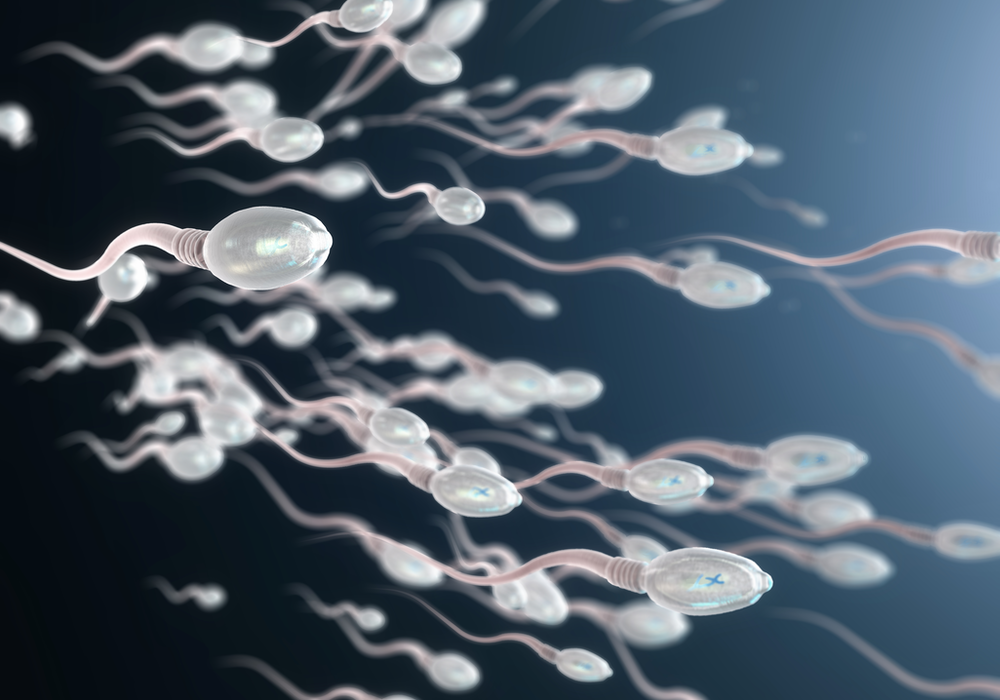Thermodynamics Reveals Coordinated Motors in Sperm Tails
It takes hundreds of thousands of molecular motors working around the clock for a sperm cell to beat its tail, which is known as a flagellum. These motors are just a few nanometers in size, making them too small to visualize in living, active sperm cells. Now Andrea Puglisi of Sapienza University of Rome and his colleagues have demonstrated a way to infer how these motors behave by looking at the precise rhythm at which a sperm’s flagellum beats [1]. Their results—which could provide the basis for a test of sperm cell health—indicate that the motors driving the tail strongly and directly interact with each other, a result that goes against previous understanding of how these motors behave. “It’s amazing to me that we can understand something about what is happening at the molecular scale by monitoring what happens at the microscale,” Puglisi says. “I wasn’t expecting that.”
In the body, the flagellum of a healthy sperm beats roughly 20 times a second. On average that means one whip of the tail every 0.05 seconds. But for any given sperm there will be some variation in that cadence. “Overall, the beating is periodic. But there are many errors from the average behavior, even for a normal sperm cell,” Puglisi says. “Healthy sperm cells can still have very erratic behaviors.”
Thermodynamics provides bounds on such errors, linking the precision of an object’s motion—in this case how much the speed of each stroke deviates from its average value—to the energy the object consumes. Specifically, the precision cannot be larger than the energy consumption—normalized so that the two quantities, which have different units, can be compared. The inequality provides useful information, Puglisi says. “Roughly speaking, this inequality tells us that if we want to make the motor of a sperm more precise—so the tail beats closer to its average value—we need to pump in more energy.”
Previous measurements on individual molecular motors have shown that they perform very near to the thermodynamic bound, meaning their precisions are close to their maximums with respect to the energy that they consume. Thus, Puglisi and his colleagues realized that if they could determine the beating precision of a collection of sperm cells and compare it to the energy consumption, they could learn something about the thousands of molecular motors behind that motion.
In their experiments, the researchers trapped the heads of sperm cells in microfabricated “cages,” which kept the sperm in place while allowing the flagella to beat as normal. They videoed the beating for a few hours and analyzed the variation of the beats over that time. “The sperm cells are very silly; they swim into these traps and then keep swimming straight,” Puglisi says. “They keep moving their tails as they would if they were free.”
Analyzing the precision with which the flagella beat, the team found a value that was significantly lower than what they had expected to find from the known energy consumption of sperm. This value instead matched the energy consumption of a single molecular motor. So, what was going on? The team performed calculations that indicated an extremely strong interaction between the molecular motors. That interaction causes the thousands of motors inside a sperm cell to act as one—rather than as independent motors. “For independent motors, the error—the variance, for example—should decrease with an increasing number of [motors],” Puglisi says. “The big error we see suggests the motors are not independent.”
Claudio Maggi, who worked with Puglisi on this study, notes that this finding goes against the prevailing view on how these motors behave. “Of course, the motors should have some coordinated behavior so that they can generate the flagella beating needed for the sperm to swim,” he says. “Our results show it is more than that—they are very closely interacting with each other, with the motors all working in consort.” Additional experiments performed by the team back up this conclusion.
“The [researchers] shine a light on the strongly coupled dynamics of molecular motors in a sperm flagellum,” says Maria Tătulea-Codrean, a biological physicist at the University of Cambridge who has studied the behavior of bacterial flagella. The evidence of coordination between motors is very exciting, she says, as this behavior could not be probed at the molecular level with current state-of-the-art techniques.
Kirsty Wan, a biological physicist who studies flagella at the University of Exeter, UK, says that the team puts “an interesting spin” on noise in flagella oscillations. She would like to see the group perform similar experiments with flagella of different lengths. That, she says, would allow them to “really confirm” the relationship between flagella fluctuations and the interactions of the molecular motors driving flagella motion.
Beyond improving understanding of how these reproductive cells behave, Puglisi and Maggi think that their results could aid in increasing positive outcomes in fertility treatments. Healthy and “sick” sperm cells consume different amounts of energy, which links to the beating precision. “From the fluctuations, clinics could learn something about the health of a cell and choose accordingly,” Puglisi says. “We have shown it’s quite easy to measure this precision in a lab.” He notes that further investigations are needed to determine the exact correlations between sperm health and beating precision. But he thinks that this method could provide the basis for a diagnostic tool. “It’s another way to help decide which cell is the most ‘fit’ for insemination. That’s important,” Puglisi says.
–Katherine Wright
Katherine Wright is the Deputy Editor of Physics Magazine.
References
- C. Maggi et al., “Thermodynamic limits of sperm swimming precision,” PRX Life 1, 013003 (2023).





